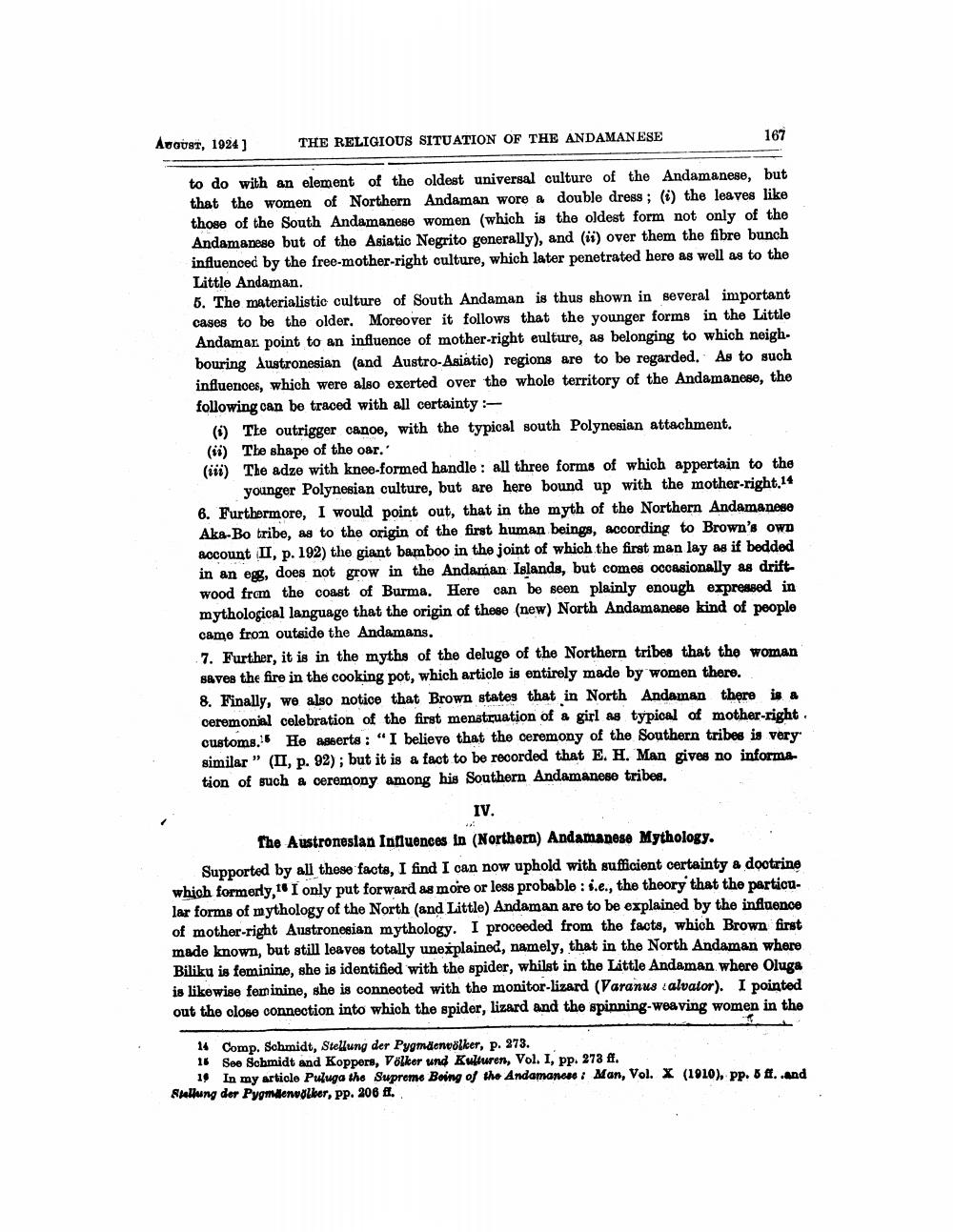________________
AUGUST, 1924]
to do with an element of the oldest universal culture of the Andamanese, but that the women of Northern Andaman wore a double dress; (i) the leaves like those of the South Andamanese women (which is the oldest form not only of the Andamanese but of the Asiatic Negrito generally), and (ii) over them the fibre bunch influenced by the free-mother-right culture, which later penetrated here as well as to the Little Andaman.
THE RELIGIOUS SITUATION OF THE ANDAMANESE
167
5. The materialistic culture of South Andaman is thus shown in several important cases to be the older. Moreover it follows that the younger forms in the Little Andaman point to an influence of mother-right eulture, as belonging to which neighbouring Austronesian (and Austro-Asiatic) regions are to be regarded. As to such influences, which were also exerted over the whole territory of the Andamanese, the following can be traced with all certainty:
(i) The outrigger canoe, with the typical south Polynesian attachment. (ii) The shape of the oar."
(iii) The adze with knee-formed handle: all three forms of which appertain to the younger Polynesian culture, but are here bound up with the mother-right,14
6. Furthermore, I would point out, that in the myth of the Northern Andamanese Aka-Bo tribe, as to the origin of the first human beings, according to Brown's Own account II, p. 192) the giant bamboo in the joint of which the first man lay as if bedded in an egg, does not grow in the Andaman Islands, but comes occasionally as driftwood from the coast of Burma. Here can be seen plainly enough expressed in mythological language that the origin of these (new) North Andamanese kind of people came from outside the Andamans.
7. Further, it is in the myths of the deluge of the Northern tribes that the woman saves the fire in the cooking pot, which article is entirely made by women there.
8. Finally, we also notice that Brown states that in North Andaman there is a ceremonial celebration of the first menstruation of a girl as typical of mother-right. customs. He asserts: "I believe that the ceremony of the Southern tribes is very similar" (II, p. 92); but it is a fact to be recorded that E. H. Man gives no information of such a ceremony among his Southern Andamanese tribes.
IV.
The Austronesian Influences in (Northern) Andamanese Mythology.
Supported by all these facts, I find I can now uphold with sufficient certainty a doctrine which formerly, I only put forward as more or less probable: i.e., the theory that the particular forms of mythology of the North (and Little) Andaman are to be explained by the influence of mother-right Austronesian mythology. I proceeded from the facts, which Brown first made known, but still leaves totally unexplained, namely, that in the North Andaman where Biliku is feminine, she is identified with the spider, whilst in the Little Andaman where Oluga is likewise feminine, she is connected with the monitor-lizard (Varanus alvator). I pointed out the close connection into which the spider, lizard and the spinning-weaving women in the
14 Comp. Schmidt, Stellung der Pygmäenvölker, p. 273.
16 See Schmidt and Koppers, Völker und Kulturen, Vol. I, pp. 273 ff.
19 In my article Puluga the Supreme Being of the Andamanese: Man, Vol. X (1910), pp. 5 ff..and Stellung der Pygmäenvölker, pp. 206 ff.




